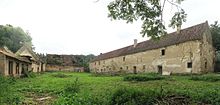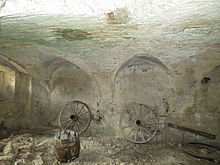Alinkov
| Alinkov | ||||
|---|---|---|---|---|
|
||||
| Basic data | ||||
| State : | Czech Republic | |||
| Region : | Jihomoravský kraj | |||
| District : | Znojmo | |||
| Municipality : | Horní Kounice , Čermákovice | |||
| Geographic location : | 49 ° 2 ' N , 16 ° 11' E | |||
| Height : | 280 m nm | |||
| Postal code : | 671 40, 671 73 | |||
| License plate : | B. | |||
| traffic | ||||
| Street: | Čermákovice - Alinkov | |||
Alinkov , also Alínkov (German Allingau , also Alingau or Alinkau ) is a settlement in the Czech Republic . It is located ten kilometers west of Moravský Krumlov and belongs partly to the communities Horní Kounice and Čermákovice in Okres Znojmo .
geography
Alinkov is located on the right bank of the Rokytná in the Jevišovická pahorkatina ( Jaispitzer hill country ). The Rokytná Nature Park extends to the west. To the north rises the Strašák (351 mnm), in the southeast the Tanárka (391 mnm) and southwest of the Výhon (368 mnm).
Neighboring towns are Dukovany and Horní Dubňany in the north, Dolní Dubňany in the Northeast, Tulešice and Oulehlův Mlyn in the east, Vémyslice the southeast, Čermákovice in the south, Medlice and Horni Kounice in the southwest, Valův Mlyn, Spálený Mlyn and Tavíkovice the west and Zámek and Rešice in Northwest.
history
The first documentary mention of a mill on the Rokytná near Čermákovice came in 1270. The road from Čermákovice through the Rokytná valley to Tulešice and Horní Dubňany led to the mill.
The Renaissance courtyard was probably built in the second half of the 16th century. There are different opinions about the builders. On the one hand, it is believed that the owner of Čermákovice, Heinrich Březnický von Náchod, had the farm next to the old mill built as a mansion. Another point of view assumes that at this time the Hutterites acquired the old mill and built a Bruderhof next to it . According to investigations by Jiří Pajer, who found several layers of Haban pottery on the site , it is certain that the farm was inhabited by Hutterites.
Together with Čermákovice, the court was also attached to the Tulešice manor in 1562. At the beginning of the Thirty Years War on December 17, 1620, imperial soldiers attacked the Bruderhof and slaughtered the residents. After the Hutterites were expelled from the country in 1622 by Emperor Ferdinand II and Cardinal Franz Seraph von Dietrichstein , Georg von Náchod and Lichtenburg received the abandoned Bruderhof with the mill. He had the former Bruderhof expanded into a stately farmyard, which was named Alinkov or Allingau. According to tradition, the farm was named after Georg's wife Alenka ; other interpretations assume that the name of the location of the farm of Alleinhof derived. A brewery was established in Alinkov before 1650. In 1660 Alinkov was its own land-based estate, which was connected to the Horní Kounice estate . With Georg's son Ferdinand Leopold Count of Náchod and Lichtenburg (1625–1672), who inherited the property in 1634, the Březnický von Náchod family died out in the male line. The land law awarded the property on April 28, 1668 to the Moravian Vice Chamberlain Mathias von Wunschwitz.
Wunschwitz sold the goods Horní Kounice and Alinkov after Ferdinand Leopold's death on March 6, 1672 for 24,900 Rhenish guilders to Johann Ernst von Montrochier. He sold Horní Kounice and Alínkov with the addition of a golden emerald-set necklace on March 20, 1675 for 17,000 Rhenish guilders to Johann Sigmund Kořensky von Tereschau and his son Johann. On October 25, 1686, the Bohemian court fief and chamber law assessor Johann Rudolf Schönwitz von Ungerswerth and Adlerslöwen acquired the goods for 26,500 Rhenish guilders. He sold Ober-Kaunitz with Allingau on August 6, 1693 for 39,500 Rhenish guilders to the Moravian land rights assessor Maximilian Ernst Freiherr Jankovsky von Vlasching (1665–1736), who was later elevated to the rank of count. Maximilian Jankovsky von Vlasching connected Ober-Kaunitz with Allingau to his Gut Skalitz . The daughters Marie Anna Leopoldina (1696–1734) and Maria Johanna (1701–1752) sprang from his marriage to Katharina Countess von Lamberg . With his death, the Jankovsky family of Vlasching ( Jankovský z Vlašimě ) died out in the male line. Allingau belonged to Gut Skalitz until 1736.
After Maximilian's death, his daughter Maria Johanna inherited the Ober-Kaunitz estate with Allingau , and Cavriani married . After her death, a dispute broke out among the relatives about the family inheritance, which was decided in 1755 by the Bohemian Queen Maria Theresa in favor of Field Marshal Heinrich Dietrich Martin Joseph Graf Daun . In the same year Marie Anna Leopoldina's son Maximilian Franz Xaver Count Daun took over the property; In 1788 she inherited his son Johann. After Johann Graf Daun died in 1795, the goods Vöttau , Skalitz, Ober-Kaunitz, Allingau, Ober-Latin and Latin fell to his underage brother Franz de Paula Josef († 1836). At the beginning of the 19th century, the official seat was moved from Skalitz to Ober-Kaunitz. In 1837 his son Heinrich Graf von Daun inherited the property. The Counts of Daun mainly farmed sheep.
In 1834 the Allingau estate was merged with the Ober-Kaunitz estate to such an extent that the usable areas were no longer recorded separately. The one-shift Allingau enrolled in the Ober-Kaunitz market consisted of an official Meierhof and a brewery. Parish and official place was Ober-Kaunitz. Up until the middle of the 19th century, Allingau remained subject to the combined estates of Ober-Kaunitz, Unter-Latin , Allingau, Skalitz, Röschitz , Chlupitz , Kordula and Biskupitz .
After the abolition of patrimonial formed Alinkov / Allingau 1849 a district of the market town of Horni Kounice in the judicial district Kromau. In 1868 Alinkov became part of the Kromau District. The brewery stopped production in 1902. With the death of Ottokar Graf von Daun, the family of the Counts of Daun died out in the male line in 1904. On the basis of a family inheritance contract , the goods fell to the four children from the marriage of Bertha von Daun († 1856) and Karl Wilhelm von Haugwitz , who, however, could not agree on the division of the inheritance and initially leased the goods. In 1905 they sold the Horní Kounice estate with Alinkov to the owner of Tavíkovice , Robert Goldschmidt. After Goldschmidt went bankrupt, the Moravian Agricultural Bank acquired both goods in the spring of 1918 and sold them to Josef Kobsinek that same year.
After the First World War , the multi-ethnic state Austria-Hungary disintegrated , and Alinkov became part of the newly formed Czechoslovak Republic in 1918 . In the course of the land reform, parts of the property were divided between 1923 and 1924; During this time, several houses were built opposite the manor on the Čermákovicer corridor. After the Munich Agreement, Alinkov remained with Czechoslovakia in 1938 and was incorporated into the Okres Moravské Budějovice. On May 8, 1945, the Red Army occupied the place. After the end of the Second World War, Alinkov was again part of the Moravský Krumlov Okres. In 1948 the estate was nationalized and two years later it was part of the newly formed JZD Horní Kounice. In the course of the abolition of the Okres Moravský Krumlov, Alinkov was assigned to the Okres Znojmo in 1961.
At the end of the 20th century, the badly dilapidated Alinkov farm was returned to the previous owners, who wanted to use it for residential and economic purposes. In the meantime the courtyard has fallen into ruin.
Local division
The Alinkov farm ( Horní Kounice No. 65 ) is located in the Horní Kounice cadastre. Opposite houses No. 41, 44 and 56 belong to the municipality of Čermákovice.
Alinkov farm
Jaroslav Sadílek assumes that the magnificent Renaissance courtyard as a manor house, not built as Bruderhof was and he lost this function until 1694, when Maximilian Ernst Freiherr Jankovsky of Vlasching the rule Skalice with the Good Horní Kounice under the administration of Bítov presented . He considers the pump house building to be the original mansion.
The archaeologist Jiří Pajer sees the last surviving Bruderhof of the Hutterites in Moravia in the courtyard. He takes the view that the 60 m long main building, which later housed the malt house, was built as a house for around 150 Hutterites. The Pajer view is also supported by the historian Bronislav Gruna.
Because of the catastrophic condition of the farm, Pajer asked for the facility to be included in the list of cultural monuments in 2008. In 2014 he proposed to the Hejtman des Jihomoravský kraj Michal Hašek to buy the farm and set up an exhibition about the Hutterites. On December 30, 2014, the Alinkov farm was declared a cultural monument.
The dilapidated main building, the ruins of the brewery, a stable, the pump house and the torso of the distillery and mill have been preserved. On the ground floor of the main building and the pump house there are Renaissance vaults, including cellars. Remnants of the original sgraffito are preserved on the facade of the pump house and on the gable side of the malt house, the latter being part of the interior decoration of the Hutterite bathhouse, which is no longer in existence, according to Pajer.
Web links
- Description of the farm on www.zanikleobce.cz
- Description of the farm on www.hrady.cz
- Description of the farm on www.archaiabrno.org
- Picture gallery from the visit of Hutterites on October 26, 2015 in Alinkov (with description of the individual photos in German)
Individual evidence
- ^ Gregor Wolny : The Margraviate Moravia topographically, statistically and historically described , III. Volume: Znaimer Kreis (1837), pp. 520-521
- ↑ http://www.zanikleobce.cz/index.php?detail=1470091
- ↑ http://www.denik.cz/jihomoravsky-kraj/historik-pajer-odkryva-unikatni-sidlo-habanu-20141008-c03c.html
- ↑ zemědělský dvůr Alinkov, mlýn, sladovna, pivovar ÚSKP 105521 in the monument catalog pamatkovykatalog.cz (Czech).






